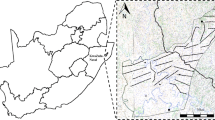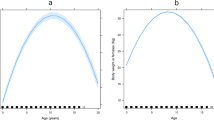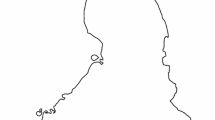Summary
A density-dependent decrement in size for wild reindeer from 12 different Norwegian herds at 16 different densities was shown using lower jawbone-length as the criterion of size. This criterion was tested and found to adequately predict body size of both bucks and does. Lactation in does did not affect jaw length but significantly affected dressed weights.
A decrement in the size of does as a result of gross density was found. This size decrement was further analysed in relation to the habitat densities in winter (R 2=0.85) and in summer (R 2=0.75) separately, in order to estimate the relative effects of each factor. For herds with adequate food in winter (no signs of overgrazing of lichens) density in relation to summer habitat and mires yielded the highest predictive power in a multiple regression. For herds with adequate summer pastures, densities per winter habitat and lichen volumes showed likewise a highly significant correlation. The inclusion of the lichen volume data in the regression increased its predictive power. The major effect of resource limitation was to delay the time of calving because a maternal carry-over effect allowed the calf a shorter period of growth to be completed during its first summer. Neonate size at birth was highly correlated with maternal size regardless of the mean calving date although the latter was significantly delayed for small-sized does in food resource-limited herds. Likewise the postnatal growth rate of all calves were not significantly different during 50 days postpartum regardless of maternal conditions in winter feeding. The summer growth rates of bucks ≧1 year did not vary significantly between herds. The age of maturity of food resource-limited does was delayed by one year and growth ceased after the initiation of reproduction. This shows that under conditions of limited resources the does with delayed births of calves allocated less energy to body growth simply because they had less time to replenish body reserves once they were freed of the energetic demands of lactation. The overriding effects of such limitation of food resources is thus to produce a time-lag for the completition of all the important life-history events, such as growth, maintenance and reproduction. From a theoretical point of view, i.e. according to the reproductive effort model their only option is to try to overcome this time limitation to reproductive success.
Similar content being viewed by others
References
Aarak E, Lenvik D (1980) Weight development in young reindeer. In: Reimers E, Gaare E, Skjenneberg S (eds) Reindeer/Caribou Symposium II Norway 1979. Direktoratet for Vilt og Ferskvannsfisk, Trondheim. pp 355–359
Bergerud AT (1964) Relationship of mandible length to sex in New Foundland caribou. J Wildl Manage 28:54–6
Bjarghov RS, Jacobsen E, Mæhle H, Skjenneberg S, Waage S (1978) Slaktevekter fra Kautokeino renslakteri ordnet etter sommerbeitedistrikt. Statens Reinforsøk, Forsøksrapport nr. 9. p 14
Blaxter KL, Hamilton WJ (1979) Maternal weight, reproduction, calf mortality and calf growth in farmed red deer (Cervus elaphus). Annual meeting The Nutrition Society. 38:149
Brody S (1945) Bioenergetics and growth. Hafner Publishing Co. New York, p 1023
Case TJ (1976) Body size differences between populations of the Chuckwalla, Sauromalus obesus. Ecology 57:313–23
Case TJ (1978) On the evolution and adaptive significance of postnatal growth rates in terrestrial vertebrates. Quarterly Review Biol 53:243–282
Clutton-Brock TH, Harvey PH (1978) Mammals, resources and reproductive strategies. Nature 273:191–5
Dahl E (1956) Rondane mountain vegetation and its relation to the environment. Skrifter Det Videnskapelige Akademi, Oslo, Matematisk-naturvitenskapelig klasse 3
Dahl E, Kallio E, Marker E, Persson A (1971) Nordisk vegetasjonsklassifisering før kartlegging. Fjellvegetationen — IBP i Norden 7:1–12
Dauphine TC (1976) Biology of the Kaminuriak population of barrenground caribou. Part 4: Growth, reproduction and energy reserves. Canadian Wildlife Service report series number 38
Espmark Y (1971) Antler shedding in relation to parturition in female reindeer. J Wildl Manage 35:175–7
Gaare E (1968) A preliminary report on winter nutrition of Wild reindeer in the Southern Scandes. Norway Symp Zool Soc Lond 21:109–115
Gaare E (1971) Vinterbeiter i Setesdalsheiene villreinområde. Rapport fra flytaksering september 1970. Direktoratet for Vilt og Ferskvannsfisk, Trondheim p 11
Gaare E, Eriksson O (in press) Lavforådet in Forelhogna Viltrapport
Gaare E, Skogland T (1975) Wild reindeer food habits and range use at Hardangervidda. In: Wielgolaski FE (ed). Ecological studies. Analysis and synthesis, 17. Fennoscandian tundra ecosystems, part 2. Springer, Berlin, pp 195–205
Gaare E, Skogland T (1979) Grunnlaget for Villreinforvaltningen. Jakt-Fiske-Friluftsliv 4:16–29
Gadgil M, Bossert WH (1970) Life historical consequences of natural selection. The American Naturalist 104(935):1–24
Gjærevoll O (1956) The plant communities of the Scandinavian alpine snowbeds. Skrifter det Kongelige Norske Videnskapelige Selskap, Trondheim
Hall WG (1975) Weaning and growth of artificially-reared rats. Science 190:1313–15
Haugen OI (1952) Oversyn over undersøkte fjellbeite i Hedmark. Norske Fjellbeite 6. Det Kongelige Selskapfor Norges vel. p 224
Haukioja E, Salovaara R (1978) Summer weight of reindeer calves and its importance for their future survival. Rep Kevo Subarctic Res Stat 14(1):1–4
Hesjedal O (1975) Vegetation mapping at Hardangervidda. In: Wielgolaski FE (ed) Fennoscandian tundra ecosystems. Ecological studies 16, Springer, Berlin, pp 74–81
Holthe V (1975) Calving season in different populations of wild reindeer in Southern Norway. In: Luick JR, Lent PC, Klein DR, White RG, Proc. 1st Int Reindeer/caribou Symp. Fairbanks. Biol Papers Univ Alaska no. 1, pp 194–198
Husum H (1963) Oversyn over fjellbeite in Sør-Trøndelag, Norske Fjellbeite 11. Det Kongelige Selskap for Norges Vel. p 93
Jacobsen E, Bjarghov RS, Skjenneberg S (1977) Nutritional effects on weight gain and winter survival of reindeer calves. Scientific reports Agric. Univ Norway 56(8):1–12
Jacobsen E, Hove K, Bjarghov RS, Skjenneberg S (1981) Supplementary feeding of female reindeer on lichen diet during the last part of pregnancy. Acta Agriculturae Scandinavica 31:81–6
Johnson FW (1937) Deer weights and antler measurements in relation to population density and hunting effort. Trans. 2nd. North American Wildlife Conference: 446–457
Julander O, Robinette WL, Jones DA (1961) Relation of summer range condition to mule deer productivity. J Wildl Manage 25:54–60
Kalliola R (1939) Pflanzensoziologische Untersuchungen in der Alpinen Stufe Finnisch Lapplands, Annales Bot Soc Zool-Bot Fennica Venamo 13(2)
Kjelvik S (1978) Plantenes produksjon på Hardangervidda. Blyttia 36:87–90
Klein DR (1964) Range-related differences in growth of deer reflected in skeletal ratios. Journ Mammal 45(2):226–235
Klein DR (1967) Interactions of Rangifer tarandus (reindeer and caribou) with its habitat in Alaska. Finnish Game Research 30:289–93
Klein DR (1968) The introduction, increase, and crash of reindeer on St. Matthew Island. J Wildl Manage 32(2):350–367
Klein DR, Strandgaard H (1972) Factors affecting growth and body size of roe deer. J Wildl Manage 36(1):64–79
Langvatn R (ed) (1977) Criteria of physical condition, growth and development in Cervidae, suitable for routine studies. Nordic Council for Wildlife Research, Stockholm, p 27
Law D (1979) Ecological determinants in the evolution of life histories. In: Anderson RM, Turner BD, Taylor LR (eds) Population dynamics. 20th. symp. British Ecological Society, London. Blackwell Scientific Publications, London pp 81–103
Lenvik D (1977) Registrering av drektighet hos simler under slakting på Harsjøen i tiden 2–5. 12. 76. Lappefogden i Sør-Trøndelag og Hedmark pamphlet. p 1
Licht P, Hoyer H (1968) Somatotropic effects of exogenous prolactin and growth hormone in juvenile lizards (Lacerta s. sicula). General Comparative Endocrinology 22:218–37
Lyftingsmo E (1974) Oversyn over granska reinbeiter. Norske Fjellbeite. Det Kongelige Selskap for Norges Vel, p 108
McCance RA (1963) The bearing of nutrition on later development. Proc 6th Intern. Nutrition Congr, Edinburg, 74–81
Michod ED (1970) Evolution of life histories in response to age-specific mortality factors. American Naturalist 113:531–550
Miller FL (1974) Biology of the Kaminuriak population of barren-ground caribou. Part 2. Canadian Wildlife Service report series number 31:p 88
Mitchell B, Brown D (1974) The effects of age and body size on fertility in female red deer (Cervus elaphus L.) X1 Intern Game Biol Congr 13E:89–98
Movinckel H, Prestbakmo H (1969) Variasjon i slaktevekt hos rein i en del sommerbeitedistrikt i Finnmark og Troms. Scientif ic Reports of the Agricultural College of Norway 58:1–26
Nakamoto T, Miller SA (1977) Effect of protein-energy malnutrition on the growth of mandible and long bone in newborn male and female rats. Journ Nutrition 107(6):983–9
Nevo E (1976) Adaptative strategies of genetic systems in constant and varying environments. In: Karlin S, Nevo E (eds) Population genetics and ecology. Academic Press, Inc., London, pp 141–158
Nieminen M, Helle T (1980) Variations in body measurements of wild and semi-domestic reindeer (Rangifer tarandus) in Fennoscandia. Ann Zool Fennici 17:275–283
Nordbø JB (1961) Oversyn over fjellbeite i Telemark. Norske Fjellbeite 4. Det Kongelige Selskap for Norges Vel., p 305
Nordhagen R (1943) Sikkilsdalen og Norges fjellbeiter. Skrifter Bergens Museum 22
Reimers E (1972) Growth in domestic and wild reindeer in Norway. J Wildl Manage 36(2):612–19
Reimers E (1980) Activity pattern: The major determinant for growth and fattening in Rangifer? In: Reimers E, Gaare E, Skjenneberg S (eds) Reindeer/Caribou Symposium II Norway 1979. Direktoratet for Vilt og Ferskvannsfisk, pp 466–474
Reimers E, Gaare E (1970) Villreinstammen på Hardangervidda må reduseres kraftig. Melding fra Statens Viltundersøkelser om villreinens kondisjon og beiteforhold på vidda. Jakt-Fiske-Friluftsliv 1(2):11–12
Reimers E, Nordby Ø (1968) Relationship between age and tooth cementum layers in Norwegian reindeer. J Wildl Manage 32(4):957–61
Reimers E, Villmo L, Gaare E, Holthe V, Skogland T (1980) Status of Rangifer in Norway including Svalbard. In: Reimers E, Gaare E, Skjenneberg S (eds) Reindeer/Caribou Symposium II Norway 1979. Direktoratet for Vilt og Ferskvannsfisk, Trondheim, pp 774–85
Reimers E, Hageland J, Winther E, Heitkøtter N, Eide G (1982) Villreinen i Rondane regionen. Jakt-Fiske-Friluftsliv 9:36–39
Ringberg T, Jacobsen E, Rygh M, Krog J (1978) Seasonal changes in levels of growth hormone, somatomedin and thyroxin in free-ranging, semi-domesticated Norwegian reindeer. Comp Biochem Physiol 60A:123–6
Ringberg T, White RG, Holleman DF, Luick JR (1981) Prediction of carcass composition in reindeer by use of selected indicator bones and muscles. Can J Zool 59:583–8
Robbins CT, Robbins BL (1979) Fetal and neonatal growth patterns and maternal effort in ungulates and subungulates. The American Naturalist 114(1):101–116
Parker GR (1981) Physical and reproductive characteristics of an expanding woodland caribou population (Rangifer tarandus caribou) in northern Labrador. Can J Zool 59:1929–1940
Scheffer VB (1951) The rise and fall of a reindeer herd. Scientific monthly 73:356–62
Scheffer VB (1955) Body size with relation to population density in mammals. Journ Mammal 36(4):493–515
Severinghaus CW (1955) Deer weights as an index of range condition on two wilderness areas in the Adirondack region. NY Fish and Game Jour 2(2):154–160
Severinghaus CW (1980) Weights of white-tailed deer in relation to range conditions in New York. NY Fish and Game Journal 26:162–187
Skogland T (1974) Villreinens habitatferd. Hardangervidda 1970–73. Report from the grazing project of the Norwegian IBP, Direktoratet for Vilt og Ferskvannsfisk, Trondheim. p 133
Skogland T (1975) Range use and selectivity by wild reindeer in Soughern Norway. In: Luick J, Lent PC, Klein DR, White RG (eds). Proc First international reindeer/Caribou Symposium, Fairbanks 1972. Biol Papers University of Alaska, special report number 1, pp 342–53
Skogland T (1978) Characteristics of the snow cover and its relationship to wild mountain reindeer (Rangifer tarandus tarandus) (L) feeding strategies. Arctic and Alpine Research 10(3):569–580
Skogland T (1979) Utbredelse, bestandsutvikling, produksjon og biotopvalg hos villrein i Snøhettaområdet. Direktoratet for Vilt og Fersvannsfisk, Viltforskningen, Trondheim. Utredning om villrein i forbindelse med Mardøla-Grytten-reguleringen. Report, p 64
Skogland T (1980) Comparative summer feeding strategies of arctic and alpine Rangifer. J Anim Ecol 49:81–98
Skogland T (1981) Comparative social organization. In: Bliss LC, Cragg JB, Heal DW, Moore JJ (eds). Tundra ecosystems: a comparative analysis. International Biological Programme 25. Cambridge University Press. pp 452–83
Skogland T (in prep a) Wild reindeer demographic strategies along a resource/density gradient.
Skogland T (in prep b) Wild reindeer foraging niche organization. Part 2 Habitat selection (in press)
Skogland T (in prep c) Wild reindeer maternal investments in relation to demographic differences.
Skogland T, Mølmen Ø (1980) Prehistoric and present habitat distribution of wild reindeer at Dovrefjell, Norway. In: Reimers E, Gaare E, Skjenneberg S (eds) Reindeer/Caribou Symposium II Norway 1979. Direktoratete for Vilt og Ferskvannsfisk, Trondheim. pp 130–41
Skoog RO (1968) Ecology of caribou in Alaska. PhD thesis. University of California at Berkeley, Berkeley, CA
Sløgedal H (1971) Heibeite i Aust- og Vest-Agder. Norske Fjellbeite 7. Det Kongelige Selskap for Norges Vel. p 244
Soldal A, Staaland H (1980) Genetic variation in Norwegian reindeer. In: Reimers E, Gaare E, Skjenneberg S (eds) Reindeer/Caribou Symposium II Norway 1979. Direktoratet for Vilt og Ferskvannsfisk. Trondheim, pp 396–401
Stcarns SC, Crandall RE (1981) Quantitative predictions of delayed maturity. Evolution 35(3):455–463
Suttie JM (1980) Influence of nutrition on growth and sexual maturation of captive red deer stags. In: Reimers E, Gaare E, Skjenneberg S (eds). Reindeer/Caribou Symposium II Norway 1979. Direktoratet for Vilt og Ferskvannsfisk, Trondheim, pp 341–49
Thorne ET, Dean RE, Hepworth WG (1976) Nutrition during gestation in relation to successful reproduction in elk. J Wildl Manage: 40(2):330–5
Trivers RL (1972) Parental investment and sexual selection. In: Campbell B (eds). Sexual selection and the descent of man. Aldine, Chicago, pp 136–179
Tuomi J (1980) Mammalian reproductive strategies: A generalized relation of litter size to body size. Oecologia (Berlin) 45(44):39–44
Varo M (1964) Tutkimuksia Poron Jalostusmahdollisuuksista. Annales Agric. Fenniae 3:296–310
Varo M (1972) Investigations on the possibilities of reindeer breeding II. Journ Scientific Agric Soc Finland 44:234–248
Varo M, Varo H (1971) The milk production of reindeer cows and the share of milk in the growth of reindeer calves. Journ Scientific and agricultural Society of Finland 43:1–10
Verme L (1965) Reproduction studies of penned white-tailed deer. J Wildl Manage 29:74–9
Verme LJ (1969) Reproductive patterns of white-tailed deer related to nutritional plane. J Wildl Manage 33:881–887
Vik E (1953) Oversyn over fjellbeite i Rogaland. Norske Fjellbeite 8. Det Kongelige Selskap for Norges Vel, p 126
Wegge P (1975) Reproduction and early mortality in Norwegian red deer. J Wildl Manage 39(1):92–100
White RG, Bunnell FL, Gaare E, Skogland T, Hubert B (1981) Ungulates on arctic ranges. In: Bliss LC, Cragg JB, Heal DW, Moore JJ. Tundra ecosytems: a comparative analysis. IBP 25, Cambridge University Press, Cambridge, pp 397–483
Wielgolaski FE (1975) Primary production of tundra. In: Cooper JP (ed) Photosynthesis and productivity in different environments. International Biological Programme 3. Cambridge University Press, pp 75–106
Author information
Authors and Affiliations
Rights and permissions
About this article
Cite this article
Skogland, T. The effects of density dependent resource limitation on size of wild reindeer. Oecologia 60, 156–168 (1983). https://doi.org/10.1007/BF00379517
Received:
Issue Date:
DOI: https://doi.org/10.1007/BF00379517




